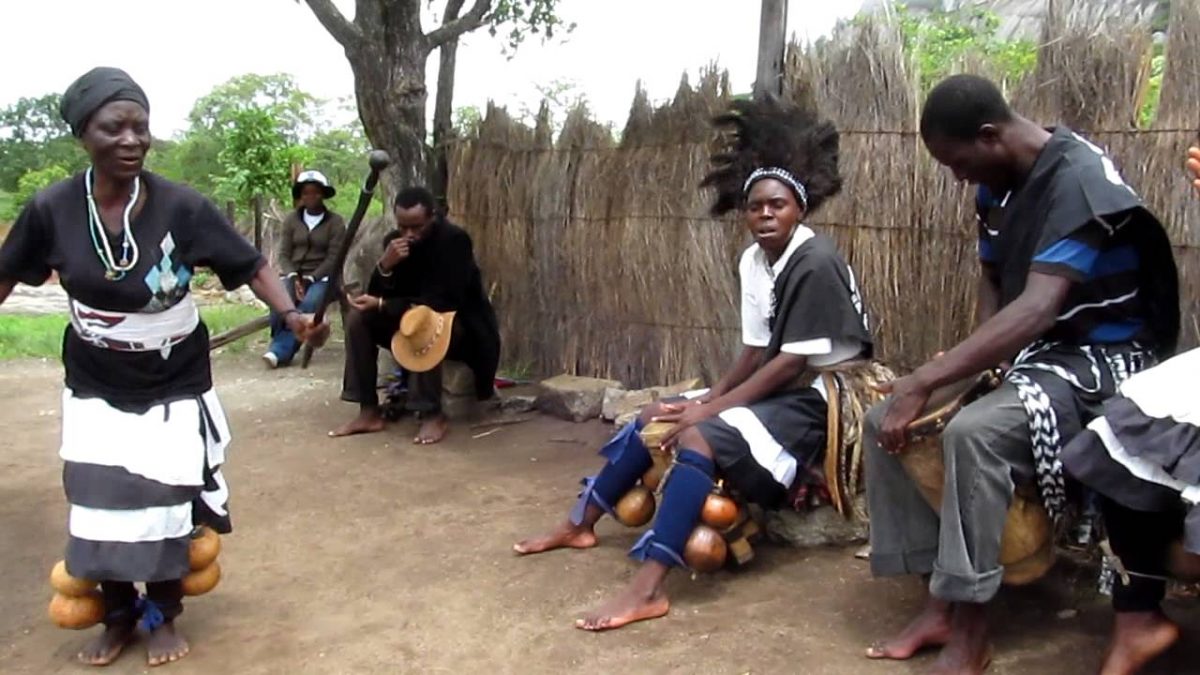By Nimorod Ushe
Bikita District is a melting pot where the cultural belief and behaviour of Ngororombe traditional dance and music has been nurtured over the years.
Background of Ngororombe traditional dance in Bikita
Located few kilometres north of Chikuku Township is a place known as Gangare. Probably, it is the cradle of Ngororombe traditional dance in Bikita. Despite various socio-economic challenges, Ngororombe has flourished from one generation to another generation among the Karanga families in Bikita. Ngororombe traditional dance in Bikita has no founder and there are no exact dates as to when was it established in that place. In short, the living heritage can be dated from time immemorial.
Inhabitants of Bikita have formed an ancestral dance group called Gangare Ngororombe Pasichigare Club which specialises in dancing, singing, and beating drums. The dance troupe of Gangare has scooped accolades from the village point of view up to the national level, encompassing, the popular Chibuku Neshamwari Traditional Song and Dance Festivals in the 1980s.
The Gangare Ngororombe Pasichigare Club has been called at the country’s national events and various social gatherings. For instance, the dance group has performed at traditional custodians’ coronation, commissioning of infrastructures, festivals, and even national dancing competitions.
As importantly, the traditional dance group was invited at the famous historic visit by the British royal Queen Elizabeth in 1992. And the royal queen was amazed by Amos Gundidza also known as Sekuru Gwamu’s drumming skills at Sheraton (now Rainbows Towers Hotel).
Ngororombe is a traditional dance insinuated for elderly men and women to celebrate the community’s bumper harvests. The aged Gangare Ngororombe Pasichigare Club is still fairly competitive with members comprised of John Mutubuki, Hwenzi Jama, Choto Mufudza, Munongo Muchini, Boas Mudoro, Togara Muchini, Rowayi Urayi, Nobetter Vangana, Amos Gundidza (also known as Sekuru Gwamu), Takaera Mudanga and Dziwiuta Mugomeri.
Above all, their patron is retired Ambassador Gabriel Machinga who is a native of Bikita. He was their biggest sponsor and brand ambassador across the world. And it also benefited him through publicity as an education, sports and culture minister back in the 1990s whenever the group performed.
Cultural significance of the Ngororombe traditional dance
The supreme objective of performing Ngororombe is for celebrating and thanksgiving to the ancestors. Ambassador Machinga pointed out that, “Ngororombe saved the cultural purposes of celebrating the community’s good harvests and remembering the dead after the harvesting period of (chirimo) in Shona “
Besides that, Ngororombe can play a fundamental role for augmenting the country’s national events such as Independence, Heroes and Defence Forces Day. “The traditional dance helps to appeal to the ancestors spirits before the parade of security officers at national events” said Mufudza. He explains that, Ngororombe’s whistle (dzvori) a horn made from an antelope is said to be blown to awaken or even invite the ancestral spirits and for their divine guidance.
More importantly, Ngororombe stanza and choreography are suggested to appeal to the ancestors for various petitions. The singing and dancing of Ngororombe can easily provoke ancestral spirits ( vadzimu/amadlosi) and people easily possessed and go into ecstasy. More so Ngororombe traditional dance would “Help people to communicate with their ancestral spirits and even the Supreme Being,” said Mufudza.
“The Ngororombe traditional song and dance is meant to impart knowledge through subtle message and re-affirm the cultural elements of the place,” said Ambassador Machinga.
Further to that, there are educational songs that assist to impart knowledge such as the norms and values of the Karanga people.
“Traditionally, there was no formal teaching among the African communities and the informal schooling through traditional music was meant to inculcate that knowledge and wisdom,” said Ambassador Machinga.
Ngororombe can benefit the local residents of Bikita with wisdom on how to use traditional elements such as medicinal herbs and musical instruments.
Additionally, “During the Ngororombe festivals, traditional herbs will be disbursed and locals will be taught on how to formulate oxides used for stage performances, the use of traditional instruments such as drums, shakers (hosho) and leg rattles ( magagada),” says Ambassador Machinga
Lastly, Ngororombe can be performed to “stimulate the spirits of the Zimbabweans for public joy, ” said Mufudza.
He added that, Ngororombe can be performed in Bikita for fun at social gatherings like beer drinking (ndhari /ndale) and mutual aid gatherings (nhimbe /hoka/ilima).
Ngororombe traditional instruments and dancing costumes
The exuberant Ngororombe traditional dance is usually accompanied by ancestral music instruments such as drums (ngoma), shakers (hosho), leg rattles (magavhu and even manjee), wooden clappers (makwa), hwamanda (horns), whistle (nyere) just to mention a few.
The most exciting element of Ngororombe is that some of their musical instruments were inherited from past ancestors. Mufudza explained that he inherited the tail of an antelope (humbure) and even whistle (dzvori) from the forebears of the Ngororombe.
During their live performance, Choto Mufudza will be the team leader. He will be commanding all the performance and including changing styles using his whistle.
Moreover, during their stage performances, dancers will be adorned with dancing costumes normally from animal skins and occasionally with outfits decorated with national emblems.
Types of traditional dances in Bikita
There are many genres of traditional dances in Bikita chief among them Chibhubhu, Chigiyo, Chikekereke, Chimbo, Chinyambera , Chipunha, Chitombi, Chokoto, Muchongoyo, Madhamburosi, Madanda, Makandira, Makwaya, Manjozi (Played during the period Madzviti or Nguni incursions), Masongano and Ngororombe.
Ambassador Machinga noted that the bulk of the traditional dances cited above appears to disappear as a result of the influence of British civilisations from 1890 to 1980. Fortunately, Chinyambera and Ngororombe traditional dances are still withstanding and capable of fascinating various audiences across the country.
The sampling of Ngororombe songs and dancing routines
Hiye hiye hiye honde honde
Nhamo yandakatamba
Hiye hiye honde honde
Second song
Nherera hoye hoye
Chikicha chikicha
Kuchachawe
“There are numerous lyrics of Ngorombe which include tribal, spiritual and for royal chiefs,” said Sekuru Gwamu.
“Unlike Chinyambera traditional dance which has several dancing routines, Ngorombe has two basic dancing routines,” said Peresu Chikono.
More importantly, Ngororombe is identical to other African traditional dances. And during traditional dance and song tournaments, they can be played under the same category of Jerusarema, Mbakumba and Muchongoyo.
“The main reason could be similarity in the dancing and drumming styles,” says Chikono.
The Ngororombe of Gangare versus Ngororombe in other cultures
Culturally, Ngororombe is not unique to Zimbabwe the traditional dance but is performed in other African countries. The notable example comes from Nyungwe people in Malawi who prefer to refer to their dance and instruments as Ngororombe, or Ngololombe in Chewa (Tracey Andrew 1947).
Besides that, Ngororombe is generally known as the “panpipe” in southern Malawi and central Mozambique. And in African tradition panpipes refer to “horns” which are typically used to hold diviner’s or sorcerer’s medicines.
Ngororombe is not confined to Gangare, it can be performed in Chirorwe, Humani, Makondo, Muvhuti and Musukutwa in Bikita. Apart from, that the Ngororombe traditional dance is also performed in other places such as Gutu, Buhera and Nyanga to mention a few.
Challenges and threats to the Ngororombe traditional dance
The sponsors to the traditional dance seem to have lessened their promotion.
Lack of sponsorship
“When Ambassador Machinga took a diplomatic role in 2000 and after his retirement from public work, the group seems to be suffering from a sponsor crisis,” said Mufudza.
In that regard, Ambassador Machinga used to sponsor food, costumes, instruments, and transport for the group. However, Ambassador Machinga argues that there is generally “Lack of disposable income at a personal level and even at the company level to sponsor traditional dances. And locally, Gangare Ngororombe Pasichigare Club as a self-sponsored group could be said it’s under demise catapulted by the socio-economic dynamics of life.”
According to Ambassador Machinga “The socio-economic lifestyle of the Shona people have changed. They can download music from their phones but you will hardly hear them listening to traditional music.”
He then opines that “Even in the Western World the Pop music and Country music have been socially overturned. The social dynamics have overturned the world and the big blow seems to be falling on traditional music. The local audience sometimes has been swooped off from the market. “
Climate change has decimated the performance of Ngororombe traditional song and dances in Bikita.
“Back then before the turn of the Millennium, agricultural produce was readily available which could make it possible for celebrations. And recently severe droughts have caused locals to rely on the drought relief which makes it impossible to engage in Ngororombe,” said Ambassador Machinga. Generally, there is a lack of disposable agricultural produce.
“Generally, the current population seems to be less physically fit for Ngororombe. Probably, it’s because of poor diets such as consuming too much sugar and this affects the personal conjecture dancing and singing Ngororombe songs “.
There are many physical workouts for Ngororombe. For example, there is an intricate of foot movements, with plenty of leg tension, twisting, and sometimes there could be jumps on both feet. “You have to be physically fit in order to dance Ngoroombe, it requires physical dexterity,” said Ambassador Machinga.
Locally there is depletion of competition amongst the Ngororombe dancers. There is no tournaments from chieftainship level, district and even national level.
“There is general lack of teams/kunja to compete with and most teams are dead,” lamented Sekuru Gwamu.
In addition to that, generally in Zimbabwe traditional dance competition “seems to be dwindling” said Sekuru Gwamu. “Back in the yore years there used to be stiff competition among the villages and the winner would walk away with the award of a flag”.
Ngororombe has some drawbacks of the inadequacy of support, lack of appreciation, and poorly understood by the contemporary societies. For instance, despite their spirited efforts on live shows, Ngororombe performers cried foul that sometimes they would walk empty-handed back home.
“Sometimes we cry as we will literally be starving after the show, ” lamented Mufudza.
Periodically, Ngororombe is poorly understood by contemporary Christians from its ancestral connections. There are some Christian fundamentalists who believed “that their church doctrine is better than African Indigenous Religion which venerated the dead and sometimes Ngororombe could be deemed as heathen,” said Sekuru Gwamu.
The Gangare Ngororombe Pasichigare Club has not been spared from the pandemic which has affected the music industry. The industry is under siege from COVID-19 which has inhibited musicians and traditional dancers to perform at gatherings of more than fifty people. Fortunately, there is a Covid-19 allowance that can cater for the upkeep of artists. The group can apply for relief assistance at the National Arts Council of Zimbabwe.
Safeguarding the Ngororombe living heritage
Protecting a constantly changing and evolving living heritage can be a mammoth task. Nonetheless, the country can counter the impact of globalisation on performance arts “through aggressive marketing of our traditional dance and music through the Internet and local mass media, ” said Ambassador Machinga.
One might be persuaded to ask perhaps “If Ngororombe cultural heritage is not nurtured, it risks becoming lost forever, or frozen as a practice belonging to the past?”. The answer might come from talent search, teaching, and coaching the youngsters as a way of safeguarding the future of Ngororombe.
Positively, Ngororombe has been sensitised and infiltrated to the local youths. Ambassador Machinga commented that “The future of Ngororombe could be secured at Chisungo Secondary School and Gangare Primary School. Both schools have Ngororombe traditional dance social clubs. The juniors and seniors students have skills and they don’t shy to exhibit their talents”.
Nevertheless, Sekuru Gwamu criticized the government for giving too much power to the pedagogy of Ngororombe to the school teachers citing the fact it was contrary to their Karanga tradition.






